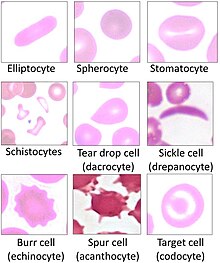Poikilocytosis
| Poikilocytosis | |
|---|---|
 | |
| Examples of red blood cell types that can give rise to poikilocytosis. |
Poikilocytosisis variation in the shapes ofred blood cells.Poikilocytes may be oval, teardrop-shaped, sickle-shaped or irregularly contracted.
Normal red blood cells are round, flattened disks that are thinner in the middle than at the edges. Apoikilocyteis an abnormally-shaped red blood cell.[1]Generally, poikilocytosis can refer to an increase in abnormal red blood cells of any shape, where they make up 10% or more of the total population of red blood cells.
Types
[edit]
Membrane abnormalities
[edit]- Acanthocytesor Spur/Spike cells
- Codocytesor Target cells
- Echinocytesand Burr cells
- ElliptocytesandOvalocytes
- Spherocytes
- Stomatocytesor Mouth cells
- Drepanocytesor Sickle Cells
- Degmacytesor "bite cells"
Trauma
[edit]- Dacrocytesor Teardrop Cells
- Keratocytes
- MicrospherocytesandPyropoikilocytes
- Schistocytes
- Semilunar bodies
Diagnosis
[edit]Poikilocytosis may be diagnosed with a test called ablood smear.During a blood smear, a medical technologist/clinical lab scientist spreads a thin layer of blood on a microscope slide and stains the blood to help differentiate the cells. The technologist/clinical lab scientist then views the blood under a microscope, where the sizes and shapes of the red blood cells can be seen.[2]
Treatment
[edit]In all cases, the treatment of poikilocytosis depends on its cause. For example, poikilocytosis can be caused by a vitamin deficiency (e.g.vitamin B12,folic acid), in which case the treatment is to replenish the deficient vitamin. It can be caused by a digestive disease, such asceliac disease,in which case the solution may lie in treating the underlying celiac disease so that nutrients can be properly absorbed.[citation needed]
Etymology
[edit]The term derives frompoikilos(ποικίλος), which means "varied" in Greek.[3][4]
See also
[edit]References
[edit]- ^Barbara J. Bain(2006).Blood cells: a practical guide.Wiley-Blackwell. pp. 71–.ISBN978-1-4051-4265-6.Retrieved10 November2010.
- ^Ford, J. (June 2013)."Red blood cell morphology".International Journal of Laboratory Hematology.35(3): 351–357.doi:10.1111/ijlh.12082.PMID23480230.
- ^(in Greek)Triantafyllidis Online Lexicon,ποικιλόθερμος, Retrieved on 2007-01-12
- ^"poikilo-".Wiktionary.Retrieved14 October2011.
